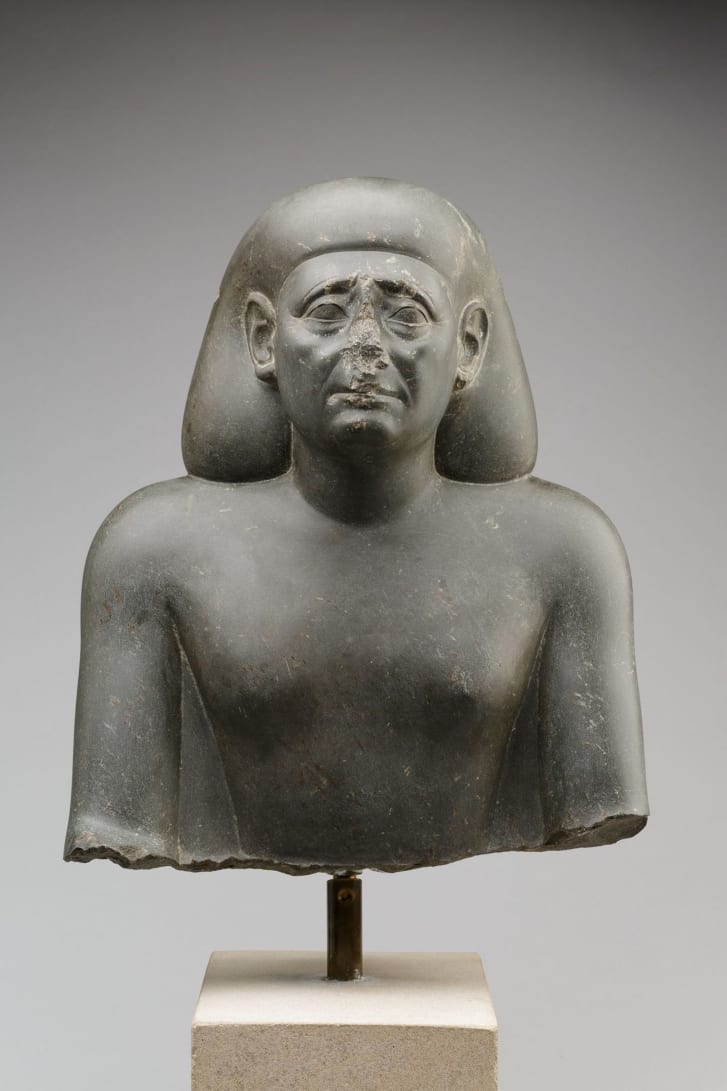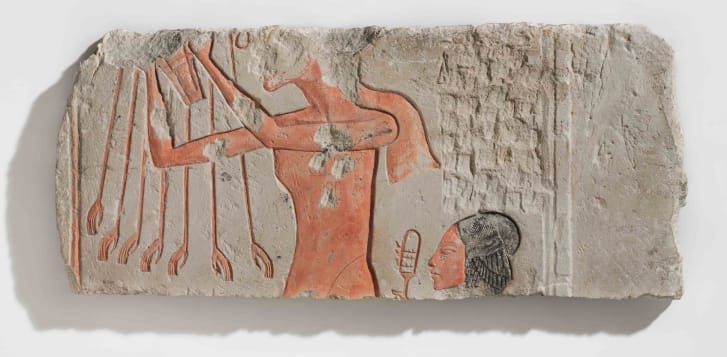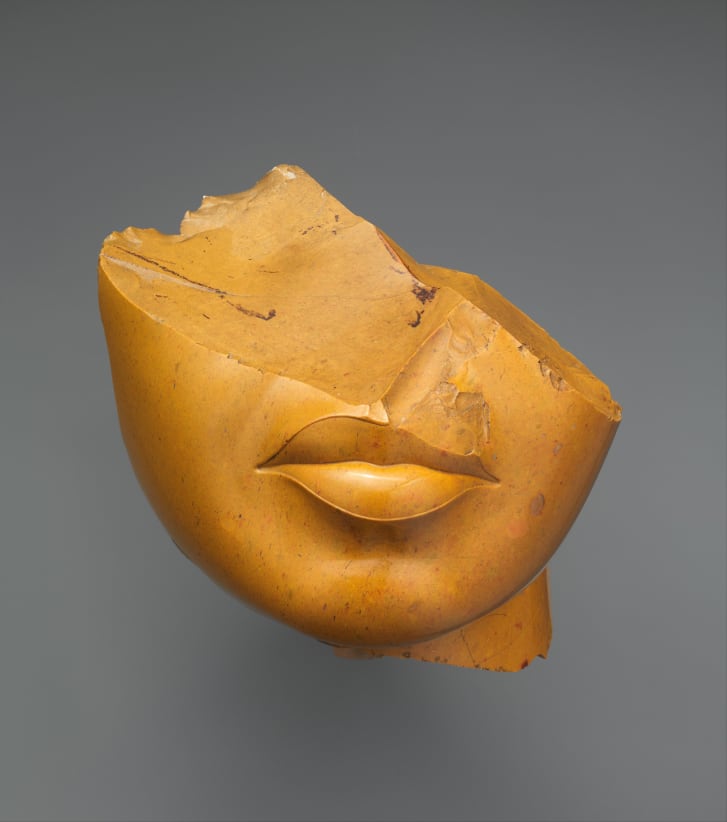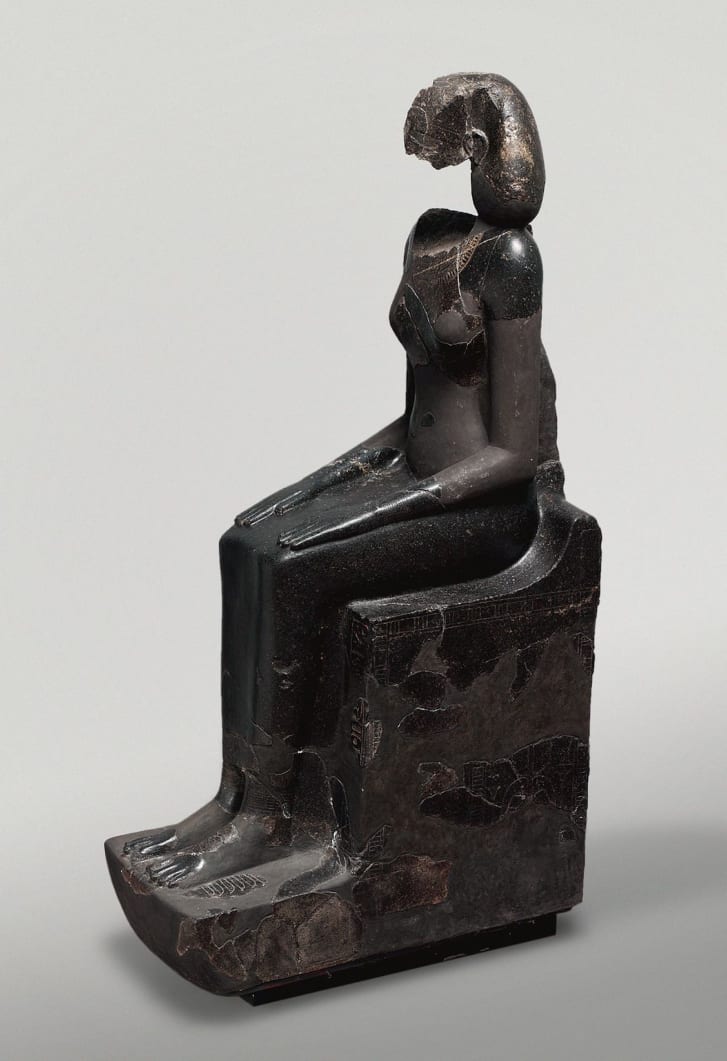Which of the Following Best Explains the Stylistic Continuity Seen in Ancient Egyptian Art
The most common question that curator Edward Bleiberg fields from visitors to the Brooklyn Museum's Egyptian art galleries is a straightforward but salient i: Why are the statues' noses broken?
Bleiberg, who oversees the museum's extensive holdings of Egyptian, Classical and ancient About Eastern art, was surprised the first few times he heard this question. He had taken for granted that the sculptures were damaged; his training in Egyptology encouraged visualizing how a statue would look if it were still intact.
It might seem inevitable that afterwards thousands of years, an ancient artifact would show wear and tear. Only this unproblematic ascertainment led Bleiberg to uncover a widespread design of deliberate devastation, which pointed to a complex set of reasons why most works of Egyptian art came to be defaced in the first place.

The bosom of an Egyptian official dating from the 4th century BC. Credit: The Metropolitan Museum of Art, New York
Bleiberg's inquiry is now the basis of the poignant exhibition "Striking Power: Iconoclasm in Ancient Egypt." A choice of objects from the Brooklyn Museum'south collection will travel to the Pulitzer Arts Foundation after this calendar month under the co-direction of the latter's associate curator, Stephanie Weissberg. Pairing damaged statues and reliefs dating from the 25th century BC to the 1st century AD with intact counterparts, the show testifies to ancient Egyptian artifacts' political and religious functions — and the entrenched culture of iconoclasm that led to their mutilation.
In our own era of reckoning with national monuments and other public displays of fine art, "Hitting Power" adds a germane dimension to our understanding of one of the world'south oldest and longest-lasting civilizations, whose visual culture, for the nigh part, remained unchanged over millennia. This stylistic continuity reflects — and direct contributed to — the empire's long stretches of stability. Simply invasions by outside forces, power struggles betwixt dynastic rulers and other periods of upheaval left their scars.
"The consistency of the patterns where damage is found in sculpture suggests that it's purposeful," Bleiberg said, citing myriad political, religious, personal and criminal motivations for acts of vandalism. Discerning the difference betwixt accidental damage and deliberate vandalism came down to recognizing such patterns. A protruding nose on a three-dimensional statue is hands broken, he conceded, merely the plot thickens when flat reliefs also sport smashed noses.

Flat reliefs often feature damaged noses too, supporting the thought that the vandalism was targeted. Credit: Brooklyn Museum
The ancient Egyptians, it's of import to notation, ascribed important powers to images of the human form. They believed that the essence of a deity could inhabit an epitome of that deity, or, in the example of mere mortals, part of that deceased human existence'southward soul could inhabit a statue inscribed for that detail person. These campaigns of vandalism were therefore intended to "deactivate an image'due south force," as Bleiberg put it.
Tombs and temples were the repositories for most sculptures and reliefs that had a ritual purpose. "All of them have to do with the economy of offerings to the supernatural," Bleiberg said. In a tomb, they served to "feed" the deceased person in the adjacent world with gifts of food from this one. In temples, representations of gods are shown receiving offerings from representations of kings, or other elites able to commission a statue.
"Egyptian state faith," Bleiberg explained, was seen as "an arrangement where kings on Earth provide for the deity, and in render, the deity takes care of Egypt." Statues and reliefs were "a meeting betoken between the supernatural and this world," he said, only inhabited, or "revivified," when the ritual is performed. And acts of iconoclasm could disrupt that power.
"The damaged part of the body is no longer able to exercise its chore," Bleiberg explained. Without a nose, the statue-spirit ceases to breathe, so that the vandal is effectively "killing" it. To hammer the ears off a statue of a god would brand it unable to hear a prayer. In statues intended to show human beings making offerings to gods, the left arm — most normally used to make offerings — is cut off so the statue's function can't exist performed (the right hand is often constitute axed in statues receiving offerings).
"In the Pharaonic period, there was a articulate understanding of what sculpture was supposed to practice," Bleiberg said. Even if a petty tomb robber was mostly interested in stealing the precious objects, he was also concerned that the deceased person might take revenge if his rendered likeness wasn't mutilated.
The prevalent practice of damaging images of the homo form — and the anxiety surrounding the desecration — dates to the beginnings of Egyptian history. Intentionally damaged mummies from the prehistoric period, for example, speak to a "very basic cultural conventionalities that damaging the prototype amercement the person represented," Bleiberg said. Also, how-to hieroglyphics provided instructions for warriors about to enter battle: Make a wax figure of the enemy, so destroy information technology. Series of texts depict the anxiety of your ain image becoming damaged, and pharaohs regularly issued decrees with terrible punishments for anyone who would cartel threaten their likeness.

A statue from effectually 1353-1336 BC, showing part of a Queen'south face. Credit: The Metropolitan Museum of Art, New York
Indeed, "iconoclasm on a grand calibration…was primarily political in motive," Bleiberg writes in the exhibition itemize for "Striking Ability." Defacing statues aided aggressive rulers (and would-be rulers) with rewriting history to their advantage. Over the centuries, this erasure oft occurred along gendered lines: The legacies of two powerful Egyptian queens whose potency and mystique fuel the cultural imagination — Hatshepsut and Nefertiti — were largely erased from visual culture.
"Hatshepsut's reign presented a problem for the legitimacy of Thutmose Iii's successor, and Thutmose solved this problem by well-nigh eliminating all imagistic and inscribed retention of Hatshepsut," Bleiberg writes. Nefertiti's husband Akhenaten brought a rare stylistic shift to Egyptian art in the Amarna flow (ca. 1353-36 BC) during his religious revolution. The successive rebellions wrought past his son Tutankhamun and his ilk included restoring the longtime worship of the god Amun; "the devastation of Akhenaten's monuments was therefore thorough and effective," Bleiberg writes. Nonetheless Nefertiti and her daughters also suffered; these acts of iconoclasm accept obscured many details of her reign.
Ancient Egyptians took measures to safeguard their sculptures. Statues were placed in niches in tombs or temples to protect them on three sides. They would exist secured behind a wall, their eyes lined up with two holes, before which a priest would make his offering. "They did what they could," Bleiberg said. "It actually didn't work that well."

A statue of the Egyptian queen Hatshepsut wearing a "khat" headdress. Credit: The Metropolitan Museum of Art, New York
Speaking to the futility of such measures, Bleiberg appraised the skill evidenced past the iconoclasts. "They were non vandals," he clarified. "They were not recklessly and randomly hitting out works of art." In fact, the targeted precision of their chisels suggests that they were skilled laborers, trained and hired for this verbal purpose. "Often in the Pharaonic menstruum," Bleiberg said, "it'due south really only the name of the person who is targeted, in the inscription. This means that the person doing the impairment could read!"
The understanding of these statues changed over fourth dimension as cultural mores shifted. In the early on Christian period in Egypt, between the 1st and third centuries AD, the ethnic gods inhabiting the sculptures were feared as pagan demons; to dismantle paganism, its ritual tools — especially statues making offerings — were attacked. After the Muslim invasion in the seventh century, scholars surmise, Egyptians had lost any fear of these ancient ritual objects. During this time, stone statues were regularly trimmed into rectangles and used as building blocks in construction projects.
"Ancient temples were somewhat seen as quarries," Bleiberg said, noting that "when you walk around medieval Cairo, yous can see a much more ancient Egyptian object built into a wall."

Statue of pharaoh Senwosret III, who ruled in the 2nd century BC Credit: The Metropolitan Museum of Fine art, New York
Such a practise seems particularly outrageous to modern viewers, considering our appreciation of Egyptian artifacts every bit masterful works of fine fine art, only Bleiberg is quick to signal out that "ancient Egyptians didn't accept a word for 'art.' They would have referred to these objects as 'equipment.'" When we talk about these artifacts as works of fine art, he said, nosotros de-contextualize them. Still, these ideas nearly the ability of images are non peculiar to the ancient world, he observed, referring to our own age of questioning cultural patrimony and public monuments.
"Imagery in public space is a reflection of who has the power to tell the story of what happened and what should be remembered," Bleiberg said. "We are witnessing the empowerment of many groups of people with different opinions of what the proper narrative is." Perhaps nosotros can acquire from the pharaohs; how we choose to rewrite our national stories might just accept a few acts of iconoclasm.
Written by .
"Hit Ability: Iconoclasm in Aboriginal Egypt" is on at the Pulitzer Arts Foundation in St Louis, Missouri, from March 22 to Aug. 11, 2019.
CNN Editor's Annotation – This article was published in partnership with Artsy, the global platform for discovering and collecting fine art. The original article can be seen here.
Source: https://egyptindependent.com/why-do-so-many-egyptian-statues-have-broken-noses/
0 Response to "Which of the Following Best Explains the Stylistic Continuity Seen in Ancient Egyptian Art"
Post a Comment